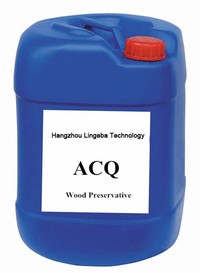Types of Preservatives

Acid Copper Chromate (ACC) Wood preservatives containing ACC are only registered for industrial and commercial uses. ACC treated wood contains hexavalent chromium or chromium (VI). Chromium (VI) is a chemical in the highest EPA toxicity category for oral, dermal, and inhalation toxicity and is also a strong skin sensitizer.

Alkaline Copper Quaternary (ACQ) ACQ wood preservatives (types A, B, C, and D) are composed of copper oxide and a quaternary ammonia compound. The absence of chemicals like arsenic or chromium has made ACQ one of the most widely used residential wood preservatives.

Benzoates are derived from benzoic acid and are more commonly used as food preservatives than the acid. Some people develop allergy-like symptoms when they are exposed to sodium benzoate. When the chemical reacts with vitamin C (ascorbic acid) in drinks under certain conditions, benzene may be produced.

Borate Wood Preservatives Borate wood preservatives are composed of naturally occurring minerals that protect wood from fungus, termites, and other wood-decomposing organisms. Borate wood preservatives are comprised of disodium octoborate tetrahydrate.

Chromated Copper Arsenate (CCA) Wood Preservatives. Chromated copper arsenate (CCA) wood preservatives contain chromium, copper and arsenic. Pressure-treated wood containing CCA is no longer used in most residential settings.

Copper Azole Wood Preservatives. Copper azole-treated wood is greenish-brown and has little to no odor. Type A (also known as CBA-A) contains copper, boric acid, and tebuconazole. Type B (also known as CA-B) contains higher concentrations of copper and tebuconazole but no boric acid. Copper azole is registered for a variety uses above and below ground, as well as in freshwater and marine decking applications.

Creosote Wood Preservatives Creosote-treated wood has either a thick black mixture of coal tar chemicals on the wood or the clear to yellowish greasy resin of the creosote bush. Many railroad ties are treated with creosote or pentachlorophenol.

Sodium nitrite is the inorganic compound with the chemical formula Na NO 2. It is a white to slightly yellowish crystalline powder that is very soluble in water and is hygroscopic. It is a useful precursor to a variety of organic compounds, such as pharmaceuticals, dyes, and pesticides, but it is probably best known as a food additive to prevent botulism.

Potassium sorbate E202 can effectively inhibit the activity of mold, yeast and aerobic bacteria which can be found in foods, such as cheese, wine, yogurt, dried meats, soft drinks & fruit drinks, canned fruits and vegetables and baked food, but can also prevent the growth and reproduction of harmful microorganisms such as Botox, Staphylococcus and Salmonella.

Sulfur dioxide might not sound good enough to eat, but this food preservative does make its way into a number of edibles, including dried fruits such as raisins, dried apricots and prunes. Sulfur dioxide is one type of sulfite, a preservative whose name might be more familiar.